At this meeting, I will present the details of the Pharma Blogosphere Reader Survey. Below is the press release, which highlights some of the findings from that survey, which I hope stimulates some discussion at the meeting.
First Ever Pharma Blogosphere™ Reader Survey Reveals That Blogs Critical of the Pharmaceutical Industry are Viewed More Credible than Blogs Supportive of the Industry
Results of the First Ever Reader Survey of the Pharma Blogosphere™ Presented at the Healthcare Blogging Summit in Las Vegas
Survey sheds light on the credibility and bias of over 20 blogs devoted to various aspects of the pharmaceutical industry
Las Vegas, NV – April 30, 2007 – A new survey of pharma blog readers presented today at the Healthcare Blogging Summit by VirSci Corporation, publisher of Pharma Marketing News newsletter, reveals that four of the TOP FIVE credible pharmaceutical-related blogs are "industry critics," as rated by industry and non-industry readers alike.
According to industry readers, the TOP FIVE credible blogs, in rank order, are In the Pipeline, Pharmalot, Pharma Marketing Blog, BrandweekNRX, and PharmaGossip. In the Pipeline blog is the only "industry supporter" in the group (see TABLE, below).
Non-industry readers also considered critical blogs more credible, although the list of blogs in this group is somewhat different (see TABLE, below).
Pharma Rag, PharmaGossip, Question Authority, and Pharma Giles were considered the most critical of the industry by all 143 survey respondents, whereas On Pharma, In the Pipeline, Drug Wonks, and Eye On FDA were considered most supportive.
Aside from bias for or against the industry and credibility, respondents rated blogs according to readability (layout, ease of reading and finding information) and usefulness (for keeping readers aware of the issues).
"Top Honors" overall went to In the Pipeline, Pharmalot, BrandweekNRX, PharmaGossip, and Pharma Marketing Blog.
Thirty percent (30%) of respondents read 2 to 9 pharmaceutical-related blogs more than once a week. Eighty-six percent (86%) read pharma blogs to keep up to date with industry news and gossip; 69% to learn more about industry business practices, regulations, etc.; and 22% to "snoop" in order to see what bloggers may be saying about their companies or blogs.
The most frequently read blogs are Pharma Marketing Blog, PharmaGossip, Pharmalot, Question Authority (Dr. Peter Rost), In the Pipeline, and Eye On FDA.
"Both the drug industry and its supporters seem to have fallen into the same credibility gap," said John Mack, publisher of Pharma Marketing News and author of Pharma Marketing Blog and Pharma Blogosphere™ blog. "The results of this survey are a wake-up call to blogs that support the industry. They must do a better job convincing readers—most of whom are likely skeptical of the industry to begin with—that the information in their blogs is credible."VirSci Corporation's survey was featured in the April issue of Pharma Marketing News. A reprint of the article "How Readable, Credible & Useful are Pharma Blogs? can be found on the Pharma Marketing Network website and purchased for $9.95. It’s free to subscribers of the newsletter (subscribe here).

TABLE: TOP FIVE credible blogs according to industry respondents (left 2 columns) vs. non-industry respondents (right 2 columns), based on the percentage of responses in the "Top 2 boxes" (Superior/Excellent). N (industry)=43 (excluding respondents who “never” or “rarely” read the blog); n>5 (includes only blogs having more than 5 responses); N (non-industry)=100 (not Never/Rarely); n>10. Excludes Pharma Watch blog because it is now closed to the public. *In the Pipeline is the only “industry supportive” blog in this group, as judged by respondents.About the Survey
One hundred forty three (143) respondents to the survey ranked 22 pharmaceutical-related blogs according to readability (layout, ease of reading and finding information), usefulness (for keeping readers aware of the issues), and credibility (accuracy of information). The survey was hosted online between February 3, 2007 and February 28, 2007. VirSci Corporation acknowledges with appreciation Chris Pounds at Myriad Pharmaceuticals for help with survey design and analysis.
About VirSci Corporation
VirSci Corporation (www.virsci.com) publishes Pharma Marketing News and owns Pharma Marketing Network, which brings together pharmaceutical marketing professionals from manufacturers, communications companies, and marketing service providers for wide ranging discussions and education on a multitude of current topics. Pharma Marketing Network & Pharma Marketing News provide executive-level content coupled with permission-based e-marketing opportunities.
Media Contact
John Mack, VirSci Corporation
Phone: 215-504-4164
Cell: 215-431-0859
E-mail: johnmack@virsci.com
# # #



 Todd Clark
Todd Clark








